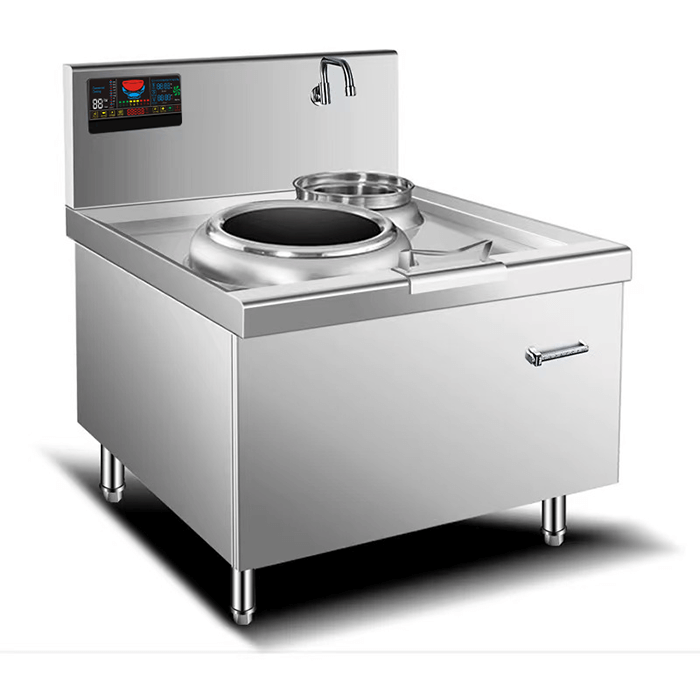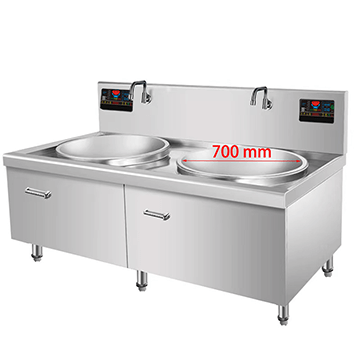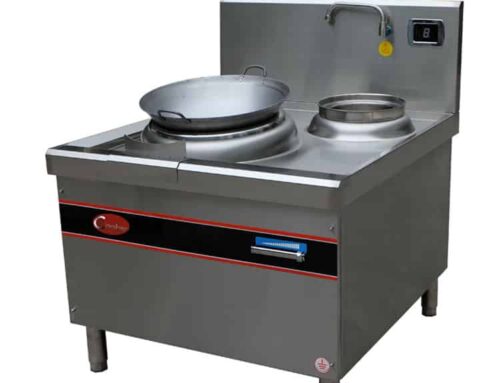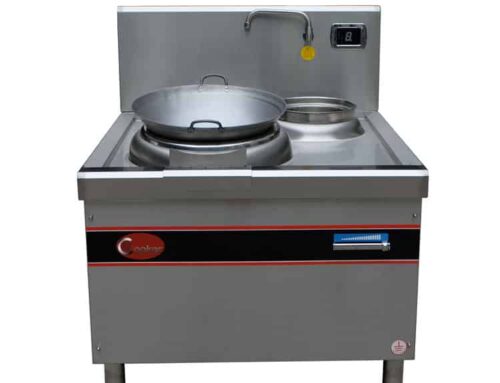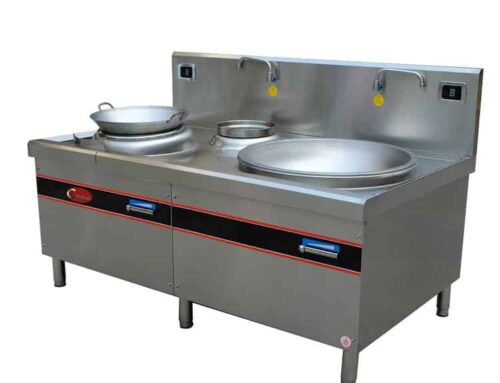Induction Wok Station: Initial Cost vs Long-Term Maintenance
For commercial kitchen owners and operators, investing in cooking equipment requires balancing upfront expenses with long-term value. A common question we hear at AT Cooker is: How does the initial cost of an induction wok station compare to its long-term maintenance expenses? With 15 years of experience understanding commercial kitchen pain points, we’ve helped hundreds of businesses navigate this decision. Below, we break down the initial investment, ongoing maintenance costs, and total cost of ownership for our commercial wok station induction cooker, comparing it to traditional gas alternatives and highlighting how our design delivers long-term savings.
1. Initial Cost: Why Induction Wok Stations Have a Higher Upfront Price
It’s no secret that induction wok cooking stations come with a higher initial purchase price compared to traditional gas wok burners. This price difference stems from advanced technology, premium materials, and energy-efficient components that define modern induction cooking equipment.
At Cooker’s Freestanding Heavy Duty Induction Wok Cooker (model ATT-ASDC 115) is a prime example. Unlike gas burners that rely on simple combustion systems, our induction wok station integrates cutting-edge induction coils, sensor switch power controllers, and 3D radiation shielding—all engineered to deliver 90%-95% energy efficiency. The use of 304# stainless steel for the body and high-quality microcrystalline glass for the cooking surface further contributes to the upfront cost, as these materials are more durable and resistant to wear than the sheet metal and cast iron used in standard gas units.
To put this in perspective, a standard gas wok burner may cost $500-$1,000 upfront, while a high-quality induction wok station like ours typically ranges from $2,000-$3,500. However, this price gap is not just about materials—it’s an investment in efficiency, safety, and durability. For many commercial kitchens, the higher initial cost is offset by long-term savings, especially when factoring in energy bills, maintenance expenses, and equipment lifespan.
Additionally, in regions like China, energy-saving policies and subsidies for electric cooking equipment can reduce the effective initial cost of induction wok stations. While subsidies vary by location, they often cover 10%-30% of the purchase price, making the upfront investment more manageable for small and medium-sized businesses.
2. Long-Term Maintenance Costs: How Induction Wok Stations Save Money
The true value of an induction wok station becomes clear when examining long-term maintenance expenses. Unlike gas burners, which have numerous moving parts and are prone to wear from open flames, induction systems are designed for minimal maintenance—thanks to their solid-state construction and advanced features.
Gas Wok Burner Maintenance Costs (Annual)
- Burner cleaning/replacement: $150-$300
- Gas line inspections/repairs: $100-$200
- Valve replacements: $80-$150
- Pilot light repairs: $50-$100
- Total: $380-$750 per year
AT Cooker Induction Wok Station Maintenance Costs (Annual)
- Surface cleaning: $20-$50
- Sensor switch calibration (rare): $50-$100
- Water filling system check: $30-$60
- No gas line or flame-related repairs
- Total: $100-$210 per year
Our induction wok station’s design directly reduces maintenance needs in several key ways:
- 304 Stainless Steel & Microcrystalline Glass: These materials resist corrosion, scratches, and heat damage, eliminating the need for frequent surface replacements. The microcrystalline glass cooking surface (400mm diameter, matched with 500×130mm pots) is easy to clean and durable enough to withstand heavy use.
- Sensor Switch & Automatic Water Filling: Mechanical wear is a major driver of maintenance costs. Our sensor switch power controller and automatic water filling system minimize moving parts, reducing the risk of breakdowns. Chinese commercial kitchen operators report that induction wok stations reduce downtime and maintenance interruptions by 40%-60% compared to gas burners.
- No Open Flames: Gas burners are prone to fire damage, clogged burners, and gas leaks—all of which require costly repairs. Induction systems use electromagnetic energy, eliminating open flames and the associated risks. This not only saves on repair costs but also reduces insurance premiums for commercial kitchens.
- Real-Time Power Display: Operators can monitor usage and avoid overloading, which prevents costly damage to internal components. This proactive monitoring extends equipment lifespan and reduces the need for emergency repairs.
While replacement parts for induction cookers (such as microcrystalline glass panels) can be more expensive than gas burner parts, these components have significantly longer service lives. A microcrystalline glass panel may cost $200-$300 to replace, but it typically lasts 5-7 years—compared to gas burners that need replacement every 1-2 years. When spread over the equipment’s lifespan, the cost per year is far lower for induction systems.
3. Energy Efficiency: A Hidden Driver of Long-Term Savings
When comparing initial cost to long-term expenses, energy efficiency is often overlooked—but it’s one of the biggest contributors to total cost of ownership. Our induction wok station boasts an energy efficiency rating of 90%-95%, while traditional gas burners typically only reach 40%-60% efficiency.
Energy Cost Comparison (Based on 8 Hours/Day, 365 Days/Year)
| Equipment Type | Efficiency | Power Consumption | Annual Energy Cost (USD) |
|---|---|---|---|
| Gas Wok Burner (15KW equivalent) | 50% | 120,000 BTU/hour | $2,800-$3,500 |
| AT Cooker Induction Wok Station (15KW) | 92% | 15KW/hour | $800-$1,200 |
| Annual Savings with Induction | — | — | $1,600-$2,300 |
This efficiency translates to substantial savings on utility bills. For a commercial kitchen using the wok station 8 hours a day, 365 days a year, the induction model saves $1,600-$2,300 annually compared to a gas burner. Over 5 years, that’s $8,000-$11,500 in energy savings—more than enough to offset the higher initial cost of the induction system.
Additionally, our induction wok station’s energy efficiency aligns with stricter environmental regulations in commercial settings. Many cities are phasing out high-emission gas equipment, and induction systems help businesses comply with these rules without sacrificing performance. This compliance avoids costly fines and ensures long-term operational sustainability.
4. Total Cost of Ownership: Induction vs Gas Over 5 Years
To fully understand the value of an induction wok station, it’s critical to calculate the total cost of ownership (TCO)—which includes initial purchase price, energy costs, maintenance expenses, and equipment lifespan. Below is a side-by-side comparison of our AT Cooker induction wok station and a standard gas wok burner over a 5-year period:
| Cost Category | Gas Wok Burner (5-Year TCO) | AT Cooker Induction Wok Station (5-Year TCO) | Savings with Induction |
|---|---|---|---|
| Initial Purchase Price | $800 (average) | $2,500 (average) | -$1,700 |
| Energy Costs | $17,500 (average) | $5,000 (average) | $12,500 |
| Maintenance Expenses | $2,750 (average) | $750 (average) | $2,000 |
| Equipment Replacement (if needed) | $800 (1 replacement) | $0 (no replacement needed) | $800 |
| Insurance Premiums (estimated) | $1,500 | $1,000 | $500 |
| Total 5-Year Cost | $23,350 | $9,250 | $14,100 |
This comparison clearly shows that while the induction wok station has a higher upfront cost, its lower energy and maintenance expenses result in a TCO that’s nearly $14,100 lower over 5 years. For commercial kitchens, this is a significant return on investment—especially when considering that our induction wok station has a lifespan of 8-10 years (compared to 3-5 years for gas burners).
Another factor to consider is downtime. Gas burners often require frequent repairs, which can shut down a kitchen during peak hours. Our induction wok station’s durability and minimal maintenance needs mean less downtime—translating to more revenue and customer satisfaction. Chinese users consistently emphasize that reliable after-sales service and spare parts availability are critical to minimizing maintenance challenges, which is why we maintain stock in the US, Germany, France, UK, Belgium, Italy, Spain, and Bulgaria for fast parts delivery.
5. AT Cooker’s Warranty & Support: Further Reducing Long-Term Costs
At Cooker, we stand behind the durability and performance of our induction wok station with industry-leading warranties and support—designed to reduce your long-term costs and provide peace of mind.
Our 5-year warranty covers all manufacturing defects for the entire commercial cooking equipment, including the induction coil, sensor switch, and 304 stainless steel body. This means if any component fails due to faulty craftsmanship, we’ll repair or replace it at no cost. Additionally, our 2-year free exchangeable policy allows you to exchange key parts (like the microcrystalline glass panel) for free within the first two years, eliminating unexpected replacement expenses.
We also offer a 1-year free return guarantee, giving you the confidence to test the induction wok station in your kitchen without risk. If you’re not satisfied with its performance, energy savings, or maintenance requirements, you can return it for a full refund within 12 months.
Our 15 years of commercial kitchen experience have taught us that equipment reliability is just as important as upfront cost. That’s why we’ve engineered our induction wok station to address the most common pain points: high energy bills, frequent maintenance, and downtime. The result is a product that not only reduces operational costs by 30%-70% but also delivers consistent performance for years.
Our global support network ensures that you’re never alone if you need assistance. Whether you have questions about maintenance, need a replacement part, or want to optimize your usage for maximum efficiency, our team of commercial kitchen experts is available 24/7. We also provide detailed maintenance guides and video tutorials to help you keep your induction wok station in top condition—further reducing the need for professional services.
6. AT Cooker’s Recommendations for Commercial Kitchens
When deciding between an induction wok station and a traditional gas burner, we recommend focusing on total cost of ownership rather than just upfront price. For commercial kitchens that operate 6+ hours a day, 5+ days a week, the energy savings and reduced maintenance costs of induction will almost always justify the higher initial investment.
Here are our key recommendations:
- Calculate Your Energy Usage: If your kitchen uses wok stations heavily, the energy savings from induction will be substantial. Use our online calculator to estimate your annual savings based on your current gas bills.
- Consider Long-Term Goals: If you plan to operate your kitchen for 3+ years, induction is the more cost-effective choice. Gas burners may seem cheaper upfront, but their short lifespan and high maintenance costs add up quickly.
- Take Advantage of Subsidies: Check local energy-saving policies for subsidies on electric cooking equipment. These can significantly reduce the initial cost of an induction wok station.
- Prioritize Durability: Choose equipment made with premium materials like 304 stainless steel and microcrystalline glass. These materials reduce maintenance needs and extend equipment lifespan.
- Choose a Reliable Supplier: Look for suppliers with a global presence and strong after-sales support. Fast access to spare parts and expert advice minimizes downtime and maintenance costs.
At Cooker, our induction wok station is designed to deliver maximum value for commercial kitchens. From its 90%-95% energy efficiency to its minimal maintenance requirements and industry-leading warranties, every feature is engineered to reduce your long-term costs. We’re proud to have helped hundreds of businesses switch to induction and save thousands of dollars annually on energy and maintenance.
If you’re ready to invest in an induction wok station that balances performance, durability, and long-term savings, we’re here to help. Contact our team today to learn more about our ATT-ASDC 115 model, request a custom quote, or schedule a demo to see the difference for yourself.
